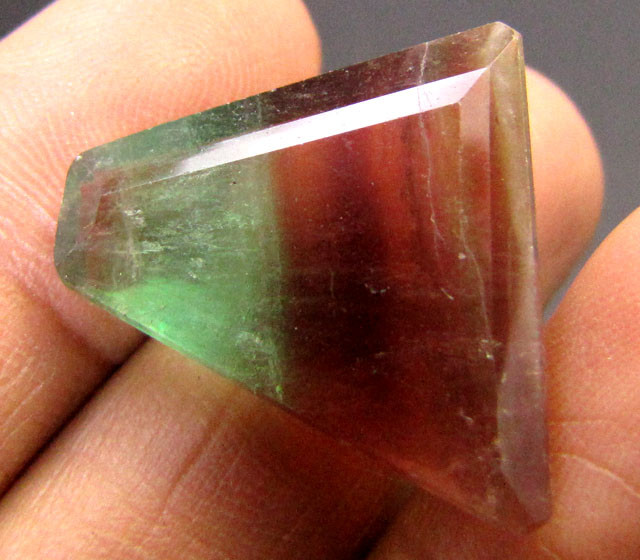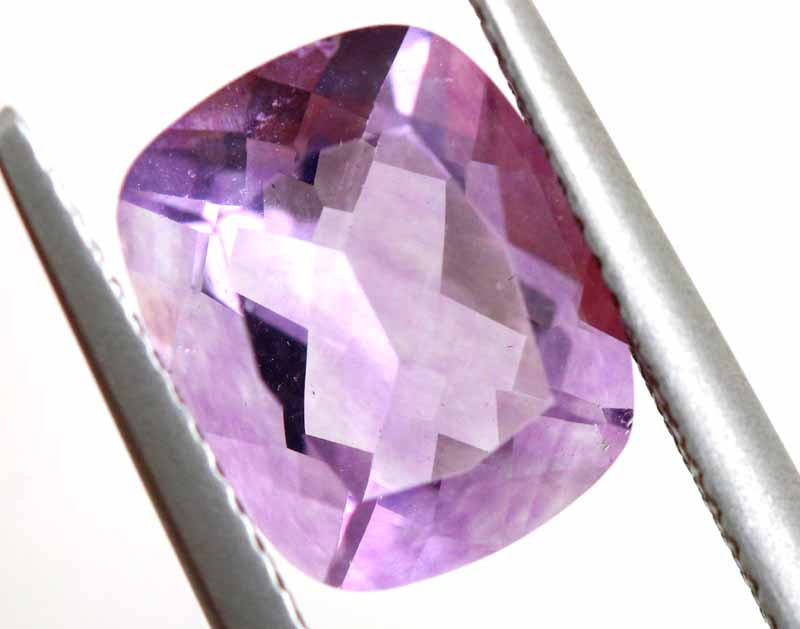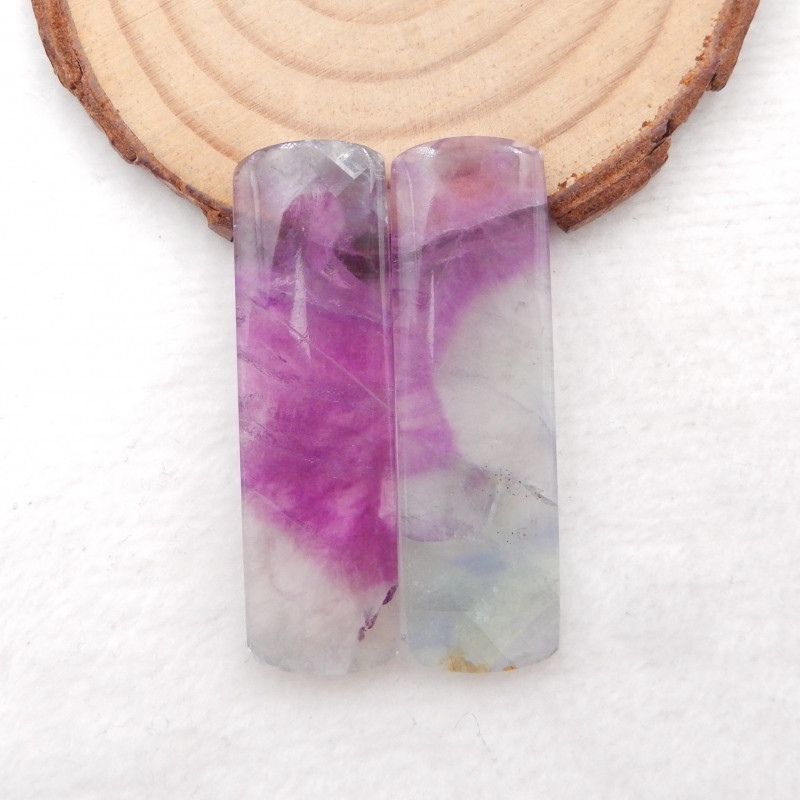
萤石宝石:含义、特性、用途等
 萤石是一种千变万化的宝石,以其丰富的色彩、令人惊叹的荧光以及丰富的制造用途而闻名。萤石被称为“世界上最丰富多彩的矿物”,它诠释了色彩生活。
萤石是一种千变万化的宝石,以其丰富的色彩、令人惊叹的荧光以及丰富的制造用途而闻名。萤石被称为“世界上最丰富多彩的矿物”,它诠释了色彩生活。
传说彩虹存在于萤石中。“雨州”伊利诺伊州以萤石为其州石,每年都会举办萤石节!
在本指南中,我们将讨论萤石的迷人特性,从萤石晶体特性背后的科学到如何使用不同颜色的萤石进行治疗。

什么是萤石?
萤石是一种种类繁多的宝石,任何人都可以找到自己完美的萤石伴侣。
你是冬季星座吗?你真幸运!萤石是摩羯座和双鱼座的守护石。
双鱼座的人往往难以保持情绪平衡,所以紫色或蓝色萤石是带来平静的完美之选。勤奋的摩羯座则受益于透明萤石的净化功效。
如果您有摩羯座或双鱼座的朋友,萤石是一份很棒的个性化礼物!
矿物特征
萤石,又称氟石,是一种由钙和氟组成的矿物。作为一种异色矿物,萤石在最纯净的状态下是无色的。然而,在其形成过程中,自然过程会产生不同的颜色。
萤石通常有色域,但有些会完全变色。变色萤石通常呈蓝色,在白炽灯下会呈现出紫色和绿色。
在莫氏矿物硬度表上,萤石的硬度为4级,这意味着它是最易碎的宝石之一。但这并不意味着您无法享受它的疗愈和珠宝功效!
继续阅读以了解萤石的所有化学特性!

萤石规格和特性
颜色:蓝色、紫色、黄色、绿色、红色、粉色、棕色、黑色、白色、灰色或无色
晶体结构:等轴/立方
光泽: 玻璃光泽
透明度:半透明至透明
折射率:1.43-1.45
密度:3.17-3.56(几乎总是3.2)
解理:八面体;[111] 上完美,[011] 上分离
断口:亚贝壳状至不规则状
发光:通常存在荧光、磷光、热释光和摩擦发光
光学现象:有时会出现变色效果;荧光灯下呈现蓝色或青色,白炽灯下呈现淡紫色或淡绿色
这涵盖了物理特性,但是萤石的形而上学特性又如何呢?
萤石的含义
“萤石”一词源于拉丁语“ fluere ”,意为“流动”,指萤石在冶炼中用作熔剂。这种宝石最初名为“氟石”(fluorospar)或“萤石”(fluorspar),至今仍沿用这些术语来描述这种宝石。
萤石的色彩和光学效应令古代人们着迷,并引发了人们对萤石晶体含义的诸多解读。古代普遍认为,萤石蕴含结晶光辉,佩戴者能够获得智慧和启迪。
古希腊人对萤石的理解与另一种宝石紫水晶类似。据说,这两种宝石都能防止过度醉酒。因此,萤石象征着纯洁和清醒。
在古代中国,紫色萤石象征着守护和梦想。紫色萤石象征着安全之盾和“梦水晶”,能够抵御噩梦,促进清醒梦的形成。
对古埃及人来说,彩虹萤石象征着他们与诸神的联系。彩虹萤石是雕刻圣甲虫的常用材料,用于雕刻各种神像。
说到神灵,印度教萤石的精神意义与口语女神瓦克和食物女神安纳普尔纳有关。
我们知道这意味着什么,但是萤石有什么作用呢?

萤石的治疗功效
所有宝石都蕴含着赋予其治愈能力的能量,这些被称为治愈石。萤石的整体功效是什么?
萤石晶体具有多种益处,因此获得了各种各样的昵称,从“天才之石”到“团结之石”。
由于蓝色是萤石中最稀有的颜色之一,蓝色萤石晶体蕴含着巨大的能量。与其他蓝色宝石一样,蓝色萤石能够赋予智慧、宁静和灵感。
蓝色萤石除了具有神奇的功效外,还有什么用途?
身体康复
萤石的物理治疗功效通常适用于治疗咽喉或肠道疾病。其他益处还包括强化关节和骨骼结构,尤其是牙齿。
此外,萤石据称能增强人体抵抗感染和自我修复的能力。缓解眩晕、头晕和头昏也是萤石的物理治疗功效之一。

情绪疗愈
从情感上来说,萤石能帮助那些正在经历困惑、幻灭或迷失方向的人。萤石能保护你免受负面情绪的侵扰,并引导你找到真正的人生目标。
您是否难以记住信息?也许您需要记住的事情太多,大脑会停止运转,从而影响您的自信心。萤石可以帮助您!
萤石的治疗特性可以提高注意力并明确方向,重回成功之路。
脉轮疗愈
萤石用途广泛,可以清洁所有七个脉轮。然而,某些颜色的萤石,例如紫色和绿色,可以打开特定的脉轮。
紫色萤石可以打开顶轮,也就是心灵与宇宙连接的地方。顶轮阻塞会导致失联和愤世嫉俗。用紫色萤石平衡顶轮,可以启迪你,让你领悟更高的使命。
对于心轮疗愈,我们推荐绿色萤石,因为绿色代表着心轮的光环。绿色萤石作为成长水晶的意义在于,它代表着心轮的开放,在那里,你可以接受过去的心痛,并允许自己展现脆弱。
千万别被骗。继续阅读,了解萤石的真正价值。
萤石宝石特性
购买宝石时,最好了解需要注意的特征,因为特定因素会影响宝石的价值。对于萤石而言,需要了解的价值因素包括颜色、净度和切工。

颜色
萤石的颜色丰富多样,如同彩虹般绚丽多彩。除了无色萤石外,最常见的萤石颜色是紫色和绿色。较为罕见的颜色包括黑色、棕色、粉色和红橙色。
大多数萤石只有一种颜色,但有些萤石晶体会呈现出色带,即多种颜色分布在整颗宝石上。一块萤石晶体上甚至可能分布着四到五种颜色!
带状萤石的颜色通常是蓝色、绿色和紫色的某种组合。此外,也可能出现黄色和橙色,因此这种多色萤石被称为“彩虹萤石”。
清晰度和光泽
在对净度进行评级时,专家会考察宝石中内含物的数量和可见度。由于彩色宝石的色调通常源于内含物,因此我们使用简化的评级系统。
根据彩色宝石分级系统,萤石的净度为II型。II型宝石通常含有内含物,但品质最佳的萤石肉眼无瑕,即没有可见的内含物。
从光泽上看,品质优良的萤石呈透明状,品质较差的萤石呈半透明状。

切
萤石最受欢迎的宝石切割是万亿形,因为万亿形可以最大限度地利用毛坯材料,并保护宝石免于沿其解理方向破裂。
萤石晶体通常会被制成凸圆形宝石或珠子。萤石的易碎性使其作为半宝石的用途有限。尽管如此,经验丰富的专家经常能创造出精美复杂的萤石雕刻品。
事实上,雕刻萤石已有数百年历史!
萤石的历史
萤石的历史如同一段引人入胜的语言之旅。这种宝石首次出现在印刷品中,是德国科学家格奥尔基乌斯·阿格里科拉16世纪的著作《萤石:关于金属本质的对话》(Bermannus; or a conversation about the nature of metals )(译自拉丁文标题)。
阿格里科拉将这种矿物称为萤石,它是德语Flusspat的一种变体,意为“河流”,而spat则指一种类似石膏的矿物。
萤石这个名字直到 1797 年才出现,当时意大利矿物学家卡洛·安东尼奥·纳皮奥内 (Carlo Antonio Napione) 使用拉丁语fluere来命名这种矿物。
在古代,拉丁语“murrina”或“myrrhina”指的是萤石。老普林尼在《博物志》中将萤石雕刻描述为奢华和地位的最高象征。
传说罗马将军庞培击败米特里达梯并占领本都后,从他手中夺走了六个萤石酒杯。另一位罗马精英佩特罗尼乌斯被诬告叛国,被判处死刑。出于怨恨,佩特罗尼乌斯打碎了他那只昂贵的萤石酒勺,然后自杀,以免皇帝继承它。
在美洲,土著人制作了萤石雕刻品和珠宝,密西西比州附近墓葬中发现的 2 世纪文物就是证据。
萤石作为雕刻材料在整个欧洲盛行。许多社会都使用萤石来制作雕像、图腾、餐具等等。
18世纪,德国人弗里德里克·豪夫(Friederike Hauffe)进行了一项实验,进一步证实了萤石的精神力量。实验者希望测试宝石对灵性敏感人群的影响,而豪夫手持萤石后,进入了恍惚状态。
我们无法确定实验是否符合科学标准,但有大量证据证明萤石具有科学应用!

化学和工业用途
萤石被发现时,氟元素尚不为人所知,因此氟最终得名于“萤石”。1852年,地质学家乔治·斯托克斯(George Stokes)在一些绿色萤石样本中发现了发光的特性,于是“荧光”(fluorescence)一词由此而来。
除了荧光光学效应外,萤石的特性使其成为光学工业中的宝贵材料。
无色萤石是一种单折射材料,不会扭曲光线,因此萤石镜片能够产生清晰的图像。事实上,无色透明萤石的色散比任何玻璃都低,非常适合用于相机、望远镜和荧光显微镜。
19世纪末,维克多·舒曼(Victor Schumann)成为首位研究萤石在透镜和棱镜应用潜力的人。此后,科学家们发明了合成萤石的生产工艺,因此合成萤石在透镜中的应用越来越广泛。
其他非宝石萤石用途包括制造氢氟酸、生产氟气和研究阿尔茨海默病(根据 2018 年的科学期刊)。
仅供参考,“萤石”如今指的是用于科学和制造过程的萤石,而萤石指的是宝石。
无论是萤石还是氟石,它们的形成方式都是一样的。

萤石的起源和来源
萤石是由热液活动形成的。在地下,岩浆加热上方的地下水,导致附近的钙和氟等元素溶解到水中。随着岩浆冷却,这些矿物结晶形成萤石!
萤石形成过程中一个引人注目的方面是它的颜色。对于大多数彩色宝石来说,铜或铁等内含物在形成过程中会混入,从而产生新的颜色。但萤石的颜色是光线造成的。我们稍后会解释。
萤石的颜色源于辐射、加热和/或稀土元素 (REE)。稀土元素是一类重金属,它们具有相同的化学性质,但又各自具有独特的性质。
稀土元素的独特性质使萤石的晶体结构发生变化,导致光线在萤石各个区域的衍射效果不同。结果呢?萤石的化学成分虽然相同,但在视觉上却呈现出截然不同的颜色。是不是很有意思?
那么,萤石的耀眼色彩是在哪些地方显现的呢?
采矿地点
萤石主要产自中国、墨西哥和南非,也有相当一部分产自俄罗斯、西班牙和蒙古。
在哪里还可以找到萤石?
巴西
加拿大
埃及
法国
德国
肯尼亚
墨西哥
摩洛哥
纳米比亚
北朝鲜
罗马尼亚
英国
可见萤石的储量十分丰富,是值得购买的宝藏哦!

萤石的价格和价值
萤石价格的首要因素是颜色。鲜艳、饱和度高、颜色图案独特的萤石价格更高。就净度而言,肉眼无瑕、透明的萤石总是比有明显瑕疵的半透明萤石更贵。
最实惠的切工是萤石凸圆形宝石,价格通常在每克拉1.50美元至5美元之间。不过,刻面萤石的价格也相当实惠,通常为每克拉3至8美元。
变色萤石的价格在每克拉10至25美元之间。萤石原石价格最便宜,在每克拉0.05至3美元之间。
无论价格如何,像萤石这样精致的宝石都需要额外的呵护。
萤石的保养和维护
萤石首饰的保养从挑选之初就开始了。由于萤石的解理和质地柔软,轻轻一击便会破碎。萤石耳环或吊坠是最安全的选择,而保护性首饰镶嵌也必不可少。
要清洁萤石,请使用肥皂水和软布仔细擦去碎屑,然后冲洗并轻轻擦干。萤石具有弱水溶性,因此请避免将其置于水中或接触刺激性化学物质。最后,务必将萤石存放在超柔软的布中,与其他宝石和珠宝分开存放。

准备好寻找你的萤石了吗?
这就是我们关于萤石宝石的全面指南!无论您佩戴萤石作为生肖石,还是用它来疗愈脉轮,或是用来装饰,萤石都能为您的生活注入活力。
搜索Gemstone Encyclopedia
最新的文章
彩虹格纹日光石是一种长石,由于内部含有各种包裹体,呈现出三种绚丽的光学效应。它绚丽多彩的光泽和格纹图案使其成为收藏家梦寐以求的珍宝!
12th Jan 2026
文章分类
How To's is where you will find helpful articles from gem Rock Auctions on how to cut gemstones, select gemstones and buy gemstones.
9文章数

